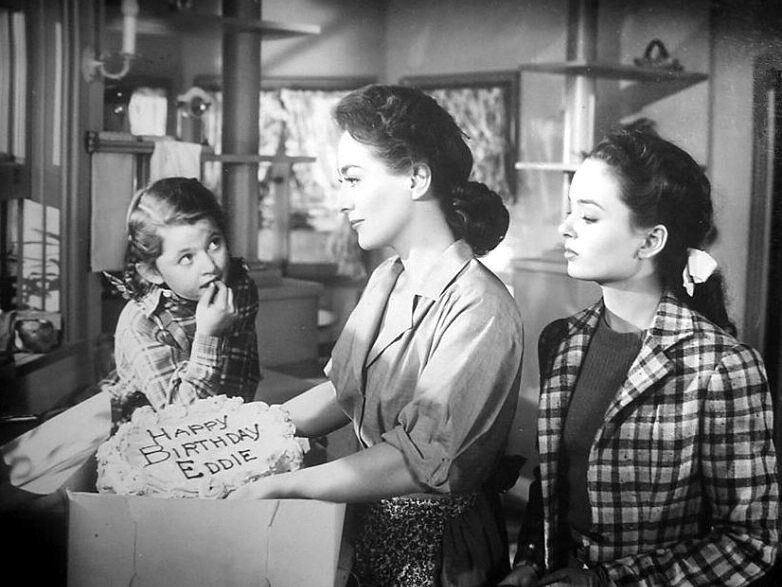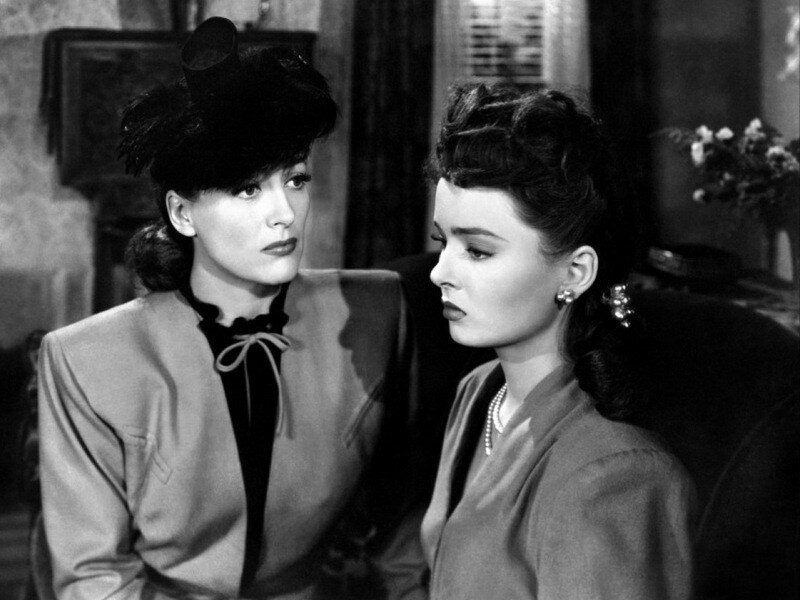The Star Wattage of Mildred Pierce (1945) | Clothes on Film – Part 36230

The 1945 cinematic adaptation of Mildred Pierce, directed by Michael Curtiz and starring, of course, Joan Crawford, is a very different beast to the 2011 HBO mini-series starring Kate Winslet. In all honestly it is not as good, but more significantly it is very different in terms of costume. Interestingly enough the mini-series, which is evidently a period piece, is closer in terms of historical accuracy than the near contemporary set Crawford version. This is not the be all and end all, because while Winslet’s Pierce may feel more real in terms of costume and setting, Crawford’s is arguably more fun. If for no other reason than to exemplify how the importance of star wattage took over everything back then regardless of what was contained in the script. Make no mistake, the story may be centred on Mildred Pierce but the movie is one hundred percent centred on Joan Crawford.
The plot of Mildred Pierce is a forward thinking piece for the era about an ambitious housewife (she of the title), abandoned by her husband who looks to support herself and her two daughters. Mildred starts off as a waitress and eventually opens her own restaurant and then a chain of restaurants. She becomes extremely wealthy, endures a tangled love life, tragedy, and the wrath of her spiteful, money grabbing daughter Veda (Ann Blyth) – who she would do anything for. What this required for Joan Crawford in terms of costume was to go from put-upon housewife to captain of industry in flashback. Costume designer Milo Anderson had to clothe Crawford as modestly as she would allow, only to then bring her character up into a world of velvet and furs thus present us with the Joan Crawford we know. Crawford was removed from her beloved Gilbert Adrian, the man credited with creating her distinctive broad shouldered, tiny-waist look. He had left the studio system in 1941 to open his own fashion house. No-one would envy Milo Anderson his task; Crawford was a fabulous talent and anxious diva.
 Jo Anne Marlow as Kay with Joan Crawford as Mildred Pierce and Ann Blyth as Veda. This is the first ensemble we see Crawford wearing within the flashback structure. Blyth’s Veda is already aspirational in a short tailored jacket (which looks to be part of a suit) and leather gloves. She has a hifalutin, equestrian air.
Jo Anne Marlow as Kay with Joan Crawford as Mildred Pierce and Ann Blyth as Veda. This is the first ensemble we see Crawford wearing within the flashback structure. Blyth’s Veda is already aspirational in a short tailored jacket (which looks to be part of a suit) and leather gloves. She has a hifalutin, equestrian air.What was going on at the time in terms of contemporary fashion? Well Mildred Pierce began production in 1944 before the end of America’s involvement in the Second World War. Clothing for women had changed much during this time. A boxy skirt suit was worn echoing that of the male lounge suit which in turn was based on traditional military uniform. In fact a lot of women’s suits were re-cut from men’s, e.g. husband or family member, because they were the most readily available. Signature details included narrow collars and wide shoulders with a slim waist. The skirt was straight and tight with a kick pleat to allow for movement. Suits were enlivened with pussy bow blouses and brooches. However the overall effect was intended to reflect the national mood – sombre. A re-fashioned ‘victory suit’ first appeared a few months after demobilisation. Adrian made an early version of this suit for Joan Crawford in the 1930s and later re-worked it for his own line. America came into their own during the war because they were cut off from the epicenter of fashion, Paris. A more relaxed, easygoing style was eventually born. Housedresses were in gingham and florals hanging just below the knee.
We generally associate gingham with the kitchen, which explains why we see so much of it on Mildred. Look fast and you’ll even spot a plaid shirt as she is furnishing her restaurant worn with a skirt and button braces (suspenders). Women have been wearing braces for as long as they have been wearing trousers, but it is unusual to find them holding up a skirt. In the U.S. these were known as ‘suspender skirts’ and generally the fabric of the skirt would match that of the braces. Interesting note that floral housedresses were often cut from flour sacks. In the 1930s flour manufacturers began using floral prints because they knew their sacks would be reused to make dresses. Mildred’s first flashback outfit is a cotton dress with stiff revers and a floral apron tied around her waist. It is a jolt to see Joan Crawford looking so dowdy, but make no mistake this a beautifully cut dress. Everything in Mildred Pierce is beautifully cut. The gentleman’s suits too, especially that worn by police Chief Inspector Peterson (Moroni Olson), featuring wide, lightly pressed lapels on a double breasted jacket. This is proper tailoring. When Mildred goes job hunting she covers up her ensemble with a raincoat and floppy brimmed hat. The subtext as to why is unclear. Was she ashamed of it? The reason could be to avoid being mocked by Veda. At this point in the story Veda has yet to enter her zenith. ‘Ruffles!’ she extorts about a white dress Mildred saved hard to buy her. This was en era of sleek not pouf; Veda is more likely to be seen in a narrow pencil skirt and short jacket. She actually does suit the finer things well; they are waiting for her.
 Joan Crawford with Ann Blyth. Note the slanted, western style jetted pockets on her jacket. There is a shoulder battle occurring in this scene. Joan wins.
Joan Crawford with Ann Blyth. Note the slanted, western style jetted pockets on her jacket. There is a shoulder battle occurring in this scene. Joan wins.Kate Winslet’s dresses in the mini-series appear more homemade than Crawford’s (read Clothes on Film articles about the costumes HERE and HERE). Indeed this was the work of one of the finest costume designers of all time, Ann Roth, someone who always looks for character over star so we would expect them to be. Joan Crawford’s housedresses are modest but still flatteringly fitted to accentuate the actress’ tiny waist and thrust her bust out. Yet what is most apparent about anything worn by Crawford is her shoulders. She must have had it written into her contract that ‘Ms. Crawford’s shoulders should extend at least an inch in diameter wider than any other female character on screen’. They truly are colossal. Perhaps the first time we really notice this is on Mildred’s polka dot summer dress worn for beach house rendezvous with Monte Beragon (Zachary Scott). The shoulders are structured, though somewhat softened by bows on her neckline. Later during the opening of her first restaurant, Mildred’s dark skirt suit is all business. The more money Mildred makes the more corporate her attire becomes. This was the genesis of the imposing 1980s power suit silhouette. Shoulders will always have a way of fortifying a person, man or woman. Further into the story, Mildred dons a light jacket with western style welt pockets and a tie at the neck that feels unmistakably ‘bolo’. She owns the room because she is Joan Crawford, but she also owns the room because she is wearing a jacket with shoulders wide enough to take someone’s eye out. However this does work for her character too; she is dressing to impress in the latest and most aggressive styles. Veda notices this and ridicules Mildred for attempting to elevate her status beyond such humble beginnings. Irony is completely lost on Veda it seems.
What we have with Joan Crawford’s Mildred Pierce is star wattage that threatens to be prioritised over her costumes. That Crawford is given a nod as ‘wardrobe advisor’ explains a lot. She did learn from Adrian; she was not a collaborator like Marlene Dietrich, but she knew her signature look and how important it was for this brand to be maintained on screen. The first we see of Joan Crawford is the last we see of Joan Crawford – in an broad fur coat with matching hat and quarterback shouldered dress with fur belt and cuffs. The flashback structure works perfectly for her; we get the immaculate housedresses and a pretty gingham waitress uniform, but we end the story as we began – on classic Joan. Stars want to look their best on film even at their worst, and Joan Crawford was the master of this.
Mildred Pierce was released on Blu-ray as part of The Criterion Collection on 27th February.
© 2017, Lord Christopher Laverty.